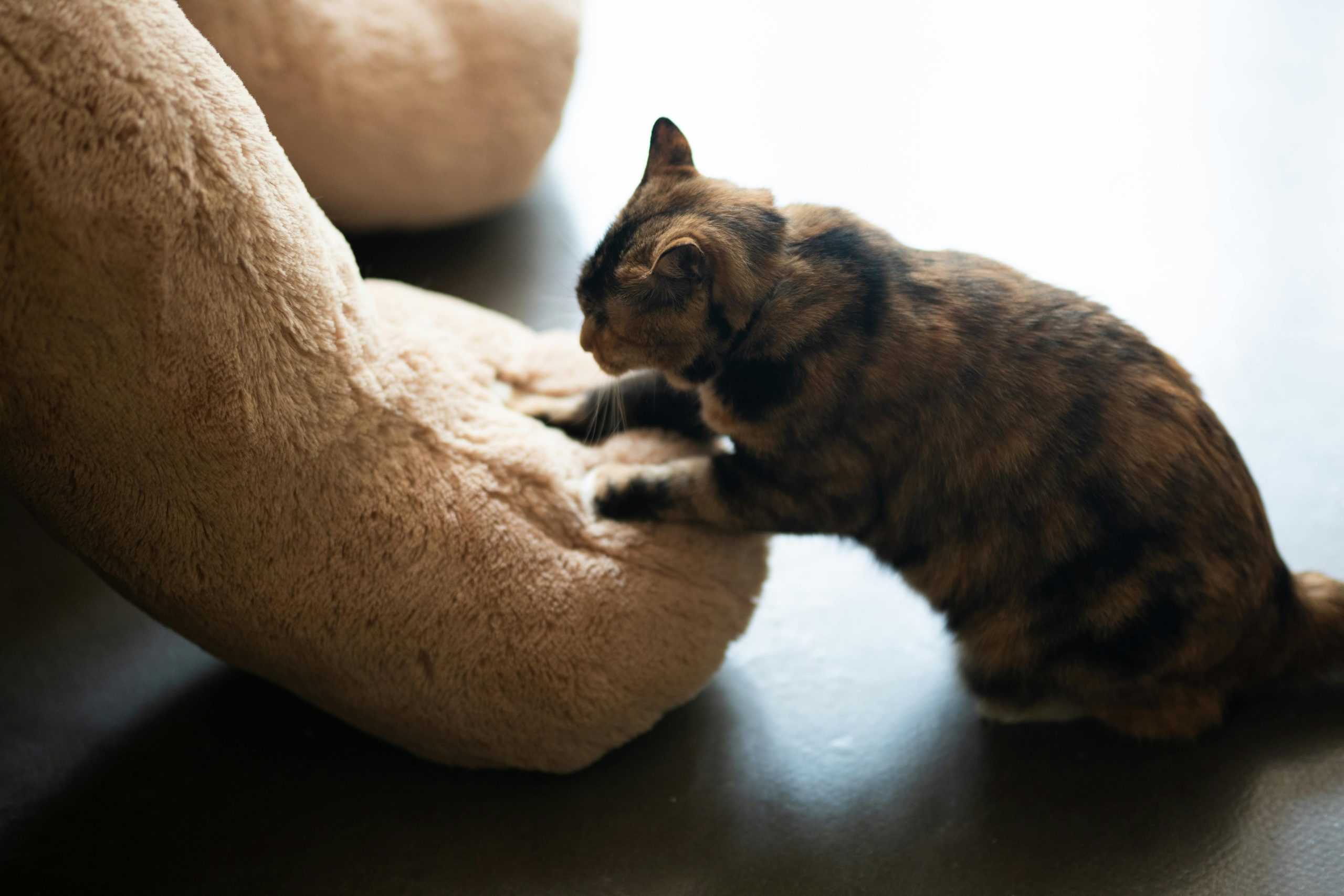You’re curled up on the couch when your cat leaps onto your lap. After a few tentative circles, she presses her paws rhythmically into your thigh, eyes half-closed, purring like a tiny engine. This endearing ritual, known as “making biscuits,” isn’t just a quirky feline habit. Kneading is an evolutionary heirloom, passed down from wild ancestors to your living room companion. At Pawlore, we decode pets’ wild roots to deepen your bond. Today, we’ll explore how this primal instinct shapes your cat’s behavior and how to redirect it compassionately.
The Wild Roots of Kneading: From Survival to Sofas
Kneading traces back to the African wildcat (Felis lybica), the ancestor of all domestic cats. For these solitary hunters, survival depended on creating safe nests in grasslands or rocky crevices
Three Evolutionary Purposes
- Nest Engineering:
Wild cats pressed down foliage to create level, concealed beds, fluffing insulation while checking for snakes or insects. - Milk Stimulation:
Kittens kneaded their mother’s mammary glands to trigger milk flow, associating the motion with safety. - Scent Claiming:
Paw pads contain pheromone glands. Kneading deposited a cat’s signature scent, declaring territory.
Why It Persists: Modern cats inherit this hardwired behavior. Kneading releases endorphins and dopamine, easing stress even without survival demands.
What Your Cat is Really Saying: Decoding the Knead
Kneading is nuanced communication. Context reveals hidden messages:
Kneading Styles and Their Hidden Meanings
| Behavior | Meaning | Wild Instinct Triggered |
| Slow, purring, eyes closed | Contentment/Relaxation | Nursing safety |
| Intense, claws extended | Territorial marking | Scent claiming |
| With blanket suckling | Self-soothing | Premature weaning memory |
| On your lap after absence | Reunion ritual | Colony rebonding |
Surprising Triggers You Can Influence
• Barometric Shifts: Dropping pressure ignites nesting urges. Offer heated beds during storms.
• Hormonal Cues: Unspayed females knead intensely during heat cycles to signal mating readiness.
• Stress Relief: Kneading reduces cortisol, anxious cats use it to self-regulate.
When Kneading Becomes Problematic: Claws, Furniture, and Compulsion
While usually benign, kneading can clash with domestic life:
Common Household Conflicts
• Furniture Damage: Repeated kneading frays fabrics and etches wood.
• Painful Affection: Unsheathed claws puncture skin during lap sessions.
• Anxiety Signals: Obsessive kneading with vocalization may indicate trauma or premature weaning.
Critical Rule: Never punish kneading, it erodes trust. Declawing causes permanent damage; trimming claws every 2–3 weeks is the humane solution.
Redirecting the Wild Instinct: 4 Compassionate Strategies
Work with your cat’s biology not against it.
DIY “Wild Nest” Station
Materials: Cardboard box (12″x12″), fleece blanket, dried catnip, sisal rope.
Steps:
- Line box with blanket, tucking edges tightly.
- Sprinkle catnip to attract interest.
- Wrap sisal around exterior for claw-friendly scratching.
- Place near favorite kneading zones. Relocate cat here with treats when needed.
Pro Tip: Warm the blanket for 2 minutes to mimic sun-warmed grass.
Pheromone Therapy
Synthetic feline pheromones (e.g., Feliway®) sprayed on designated blankets satisfy territorial urges harmlessly.
Positive Reinforcement Protocol
• Reward kneading on approved surfaces with high-value treats (freeze-dried chicken).
• Pair claw-trimming with cuddle sessions to reduce stress.
Anxiety Intervention
For compulsive kneaders:
• Consult a vet to rule out arthritis.
• Use calming supplements like Purina® Calming Care (vet-approved).
Kneading in the Wild: A Feline Family Tradition
This behavior spans the Felidae family, proving its evolutionary value:
Wild Cat Kneading Comparisons
| Species | Observed Behavior | Purpose |
| African Wildcat | Pressing leaf litter | Creating hidden nests |
| Lynx | Kneading snow pre-rest | Insulating sleeping area |
| Cheetah | Paddling soil post-hunt | Stress relief |
The Deeper Bond: Why Honoring Instincts Matters
When your cat kneads you, it’s performing “alloparenting”, treating you as family. Biologists believe this ritual blends kittenhood trust with wild ancestry. By redirecting gently, you:
• Preserve their natural expression without sacrificing your sofa.
• Strengthen cross-species trust, validating their evolutionary identity.
Kneading is a bridge between your cat’s wild past and domestic present.
Redirecting it compassionately deepens mutual understanding.
— Dr. Susan Krebsbach, DVM, Veterinary Behaviorist
Key Takeaways: Embrace the Instinct
- Kneading is non-negotiable biology. Never punish it.
- Use species-appropriate outlets like nesting stations.
- Trim claws regularly (never declaw).
- Consult a vet if kneading becomes obsessive.
Final Thought: That rhythmic push-pull of paws is a testament to your cat’s ancient lineage. By channeling it thoughtfully, you honor the wild soul in your home.
Explore Wild Instincts on Pawlore:



One thought on “Why Do Cats Knead? The Wild Nesting Instinct You Can Redirect Today”